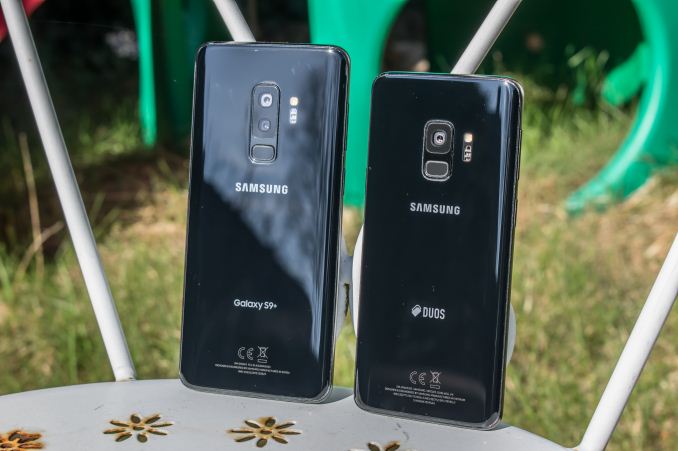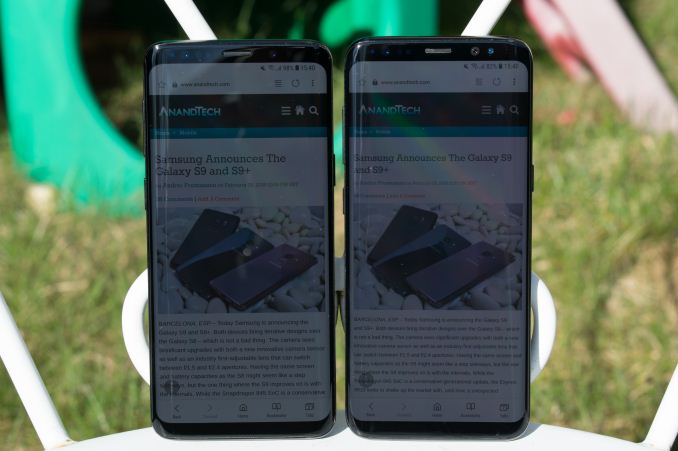The Samsung Galaxy S9 and S9+ Review: Exynos and Snapdragon at 960fps
by Andrei Frumusanu on March 26, 2018 10:00 AM ESTConclusion & End Remarks
The conclusion for the Galaxy S9 is always the toughest part to write as it’s where we have to reconcile all the pros and cons of the device and making a verdict on its value as a product to customers.
In terms of design, the S9 iterates on the S8 and I think that’s definitely a positive until Samsung somehow produces a better design overhaul. The changes we find here aren’t exactly ground-breaking and most people will get used to them very fast. The fingerprint scanner location is among the biggest ergonomics changes and while for me personally it didn’t do much, there’s plenty of people who find it an improvement.
The speaker sound quality of the Galaxy S9 is a massive improvement and this is now by far the best sounding smartphone device. The stereo speakers as well as the audio processing tuning along with the improved main speaker design all just provide a much better experience. I may not have covered this in the introduction, but Samsung’s choice to retain the 3.5mm jack is absolutely the right thing to do. I’ve got very strong feelings about companies’ rationales behind removing the headphone jack and find their reasoning either misguided or outright misleading, and just very anti-consumer choice. Here’s to hoping that Samsung sticks with it in the future, and as absurd as this is that I have to praise them for it, I have to do it to ensure that companies listen.
The screen of the Galaxy S9 holds very little surprises as it has only marginal improvements over the S8. It’s still among one of the best screens on smartphones, and honestly there’s not much more to say.
The camera of the Galaxy S9 for me had some high points and some low points. The high points are that the variable aperture of the S9 has real benefits and direct advantages in picture quality in day-light shots. The S9’s reduced usage of sharpening provided the cleanest pictures among all smartphones and thanks to its improved sensor its effective spatial resolution is actually higher than some higher resolution camera devices. The low-light shots also come with a quality improvement over the S8 – although it will depend on the lightning and scene to notice them at their full effect. Right now the S9 has the best low-light camera.
While the hardware of the S9’s camera definitely deserves praise, the software has notable issues in daylight shots. The Galaxy S9 has a very bad tendency to overexpose and compress the image’s dynamic range. In Pro mode these issues largely go away, but for the Galaxy S9 to offer a better point-and-shoot experience than the S8 or the new iPhones, Samsung needs to rework its camera calibration in Auto mode as right now it can be the odd one out in terms of results.
Finally, the biggest story for the Galaxy S9 is its big contrast in terms of SoC hardware. Ever since we first heard about the Exynos 9810 we had very large expectations and we knew there would be some tangible differences between Exynos and Snapdragon variants. The expectations couldn’t be more shattered than the results we got. While the Snapdragon 845 variant of the Galaxy S9 performed largely as advertised and as we had been told to expect by Qualcomm, the Exynos 9810 failed to live up to its hype in real-world scenarios. Effectively, the Exynos 9810 variant and as evidenced by all the data we collected, is the slower variant of the two. The root cause here has been identified as the extremely conservative scheduler and DVFS mechanisms which essentially nullify any advantage the new M3 cores have in synthetic benchmarks.
In 3D benchmarks, the Exynos 9810 posted very healthy efficiency improvements and even sometimes managed to catch up to last year’s Adreno 540 – something I hadn’t expected. Qualcomm’s new Adreno 630 raises the bar in terms of peak performance, however the promises of increased efficiency have not materialised in the commercial hardware as the performance boost comes at a cost of increased power. Effectively, when looking at sustained workloads, the Snapdragon 845 isn’t any faster than the Snapdragon 835 in its GPU department. Fortunately for Qualcomm, they’re still in the lead and this is not a deal-breaker for the Galaxy S9.
While the performance advantage of the Snapdragon 845 variant over the Exynos 9810 variant is something we could live with, the battery life results of the Exynos is definitely a deal-breaker. I’m not sure of the root cause here and whether it’s something that can be fixed by software, but showcasing such a battery runtime regression over its predecessor is universally something that we can all agree on as not acceptable for a flagship device. Based on our testing, it’s especially in heavy use-cases where this will most evident. The Snapdragon 845 variant performed as expected in the battery life tests.
Finally the recommendation of the Galaxy S9 will be based on which market you are in and which variant you’ll be able to purchase. The Snapdragon 845 variant in the US, China and Japan is a healthy upgrade over its predecessors and I don’t really have much to say against it as a phone, besides the camera exposure issues. Here Samsung iterated and perfected over the S8, and whether the S9 is worth to you as an upgrade is something you’ll need to decide based on its individual parts, because as a package, the Snapdragon S9s don’t disappoint.
For readers in markets with the Exynos variant I need to take a slightly different tone. Make no mistake as I say that the Exynos S9 is by far not a bad phone. If you come from older generation devices you will see significant upgrades, but as a flagship coming at a price premium we expect a no-compromise device, and here is where the Exynos S9 doesn’t tick all boxes. The battery life regression that we measured is the single most concerning aspect of the device. Here buyers will need to consider the device with caution and well-thought out consideration and should maybe apply a wait & see approach over the coming months – for one to see if Samsung resolves the issues via software, and secondly, to await the release of competitor’s new product lines for possible better alternatives.












190 Comments
View All Comments
robertkoa - Tuesday, July 3, 2018 - link
Yes. Has a great built in battery monitor that puts apps to sleep but they become immediately available.Also Location OFF unless using GPS ...Avoid having Apps and Sites give you notifications.
Avoid unnecessary extra tabs opened.
Screen brightness at 30% indoors.
I squeeze a lot of SOT on 4GLTE 6 hours browsing 40 minutes of calls 40 minutes of Youtube 20 minutes of emails on a charge.
Have not used Camera for a long time yet.
8 to 9 hours SOT.Qualcomm S9 USA not sure what people are doing who get half this.
I AM afraid to download the new .75GIG software update...why do they need .75GIG for security patches...?
Larger Operating System with constant security in deep background APPS could kill my battery life ...
peevee - Thursday, April 5, 2018 - link
WOW, A55 cores are so tiny compared to M3, one M3 cores takes as much silicon as 8 A55 cores. In the same amount of silicon, they could have had 1 M3 core and ~28-30 A55s. It would be just as fast in single-thread tasks but much faster AND more energy-efficient in multi-thread ones.peevee - Thursday, April 5, 2018 - link
Do I see it correctly that good old 820 is both most efficient and one of the fastest in most cases? Such a degradation!peevee - Thursday, April 5, 2018 - link
"we see the Snapdragon 845 within spitting distance of the Snapdragon 835’s energy usage throughout most of the workloads, sometimes winning and sometimes losing"Where 845 is winning in energy usage? What are you talking about? Either something is wrong with your graphs (color coding?), or 820 is significantly better than 835 which is significantly better than 845.
mkstowegnv - Thursday, April 5, 2018 - link
Thank you for putting all the work into this valuable review. But. You did not talk about GNSS - GPS, GLONASS, etc. (and AT has not had a story involving GNSS for 5 years). You can only do so much and it is another world of expertise, but it would be particularly valuable to look into GNSS for this phone. 2018 was supposed to be the year of phones with multifrequency GNSS leading to centimeter accuracy (and more to the point for the average user much better and faster performance in urban canyons, thick forests and other unfavorable environments and times). Broadcomm's BCM4775x series of L1, L5 chips was going to make this happen (but they have remained mum about which phones would use the chip). The problem is that Qualcomm SOCs are unlikely to incorporate their archrival's products, and all the leaks and previews of all the flagship phones for the next year indicate Qualcomm Snapdragon SOCs. Huawei uses non-Qualcomm but their just released p20 uses the previous generation, L1-only Broadcom chip. The only BCM4775x phone that anyone has seen and maybe the only one for the forseeable near future is the Exynos version of the S9+ which Techinsight's teardown and XDA hackers confirm has the BCM54772. It was not announced or documented by Samsung, and XDAers still don't know if it is picking up the L5 signal in an accessible way. What heroic figure(s) could possibly measure and compare GNSS accuracy in recent phones and possibly hack the Exynos S9+ to use L1 and L5 and get the best accuracy?KD323 - Thursday, May 17, 2018 - link
Thanks for the writeup! By the way, what do you think of these wooden phone cases for S9/S9 Plus?https://kaloadesigns.com/collections/galaxy-s9Peaches - Sunday, May 27, 2018 - link
Does these tests mean, that The E9810 with The CPU-Limiter from The Power Saving Mode activated , is as fast and more efficient than The E8895? BTW:awesome test and i love Hose detailed and fact-based you are.Taleim - Wednesday, May 30, 2018 - link
I hear that the may update improves battery life, any chance of running the tests again? CheersLodestone - Thursday, August 30, 2018 - link
Same here. Would greatly appreciate if you could run the exynos battery tests again to see if updates have improved the problem.CyberRain - Wednesday, August 8, 2018 - link
How to Catch a Cheating SpouseIt offers you not only to view the files on the device, but also download them on your personal computer.
The tool gives you absolute anonymity. Your spouse will never find out you spy on his/her cell phone.
There is no need on possessing the target device. You can spy on your Spouse remotely. The entire process does not need any physical access.
contact: Mobile Hack Expert